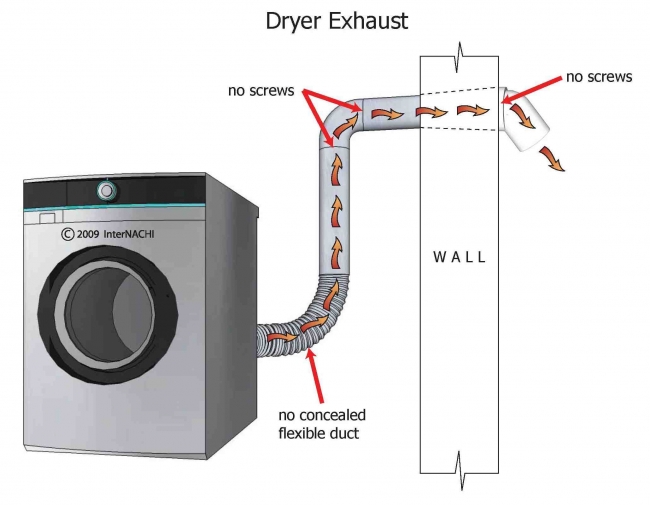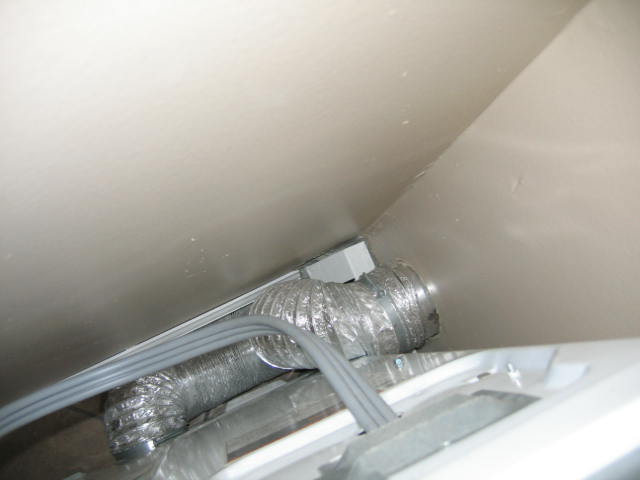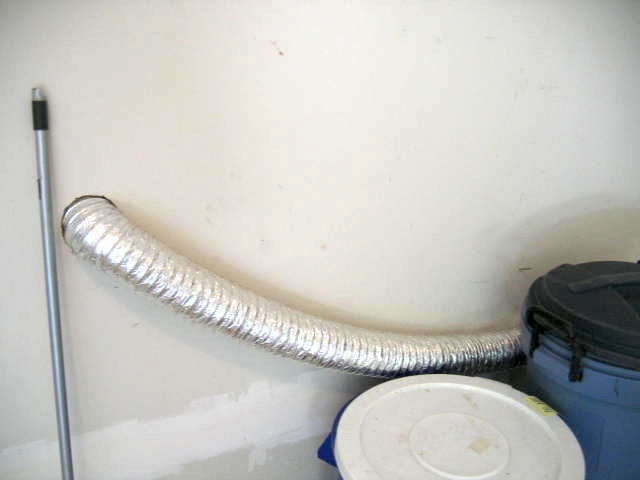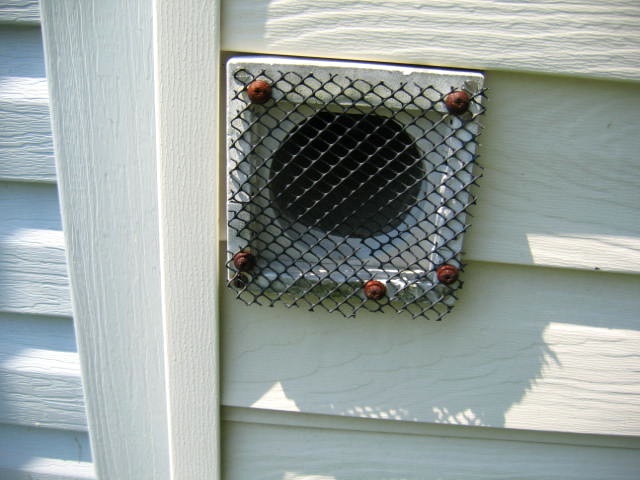Inspecting the Dryer Exhaust
by Nick Gromicko, CMI® and Ben Gromicko
Updated November 2018
According to InterNACHI's Standards of Practice, home inspectors are required to inspect the mechanical exhaust system for the clothes dryer. The clothes dryer must vent directly to the outdoors, unless it is a ventless dryer equipped with a condensate drain (a listed and labeled ductless condensing dryer).
Devices that allow moisture and heat to vent back into the home should not be used. Dryer exhaust ducts must terminate at the exterior of the building.

Moisture
A clothes dryer will vent about a gallon of water for each load of laundry. If the dryer vent discharges into a crawlspace, attic, or other building cavity, the potential for moisture-related damage is significant. Clothes dryers must vent directly to the outside.
Dryers should use approved exhaust ducts. Ducts made of vinyl, nylon or foil are not recommended. If used, they will void the warranty of most dryers. Spiral-duct designs often trap lint, which can clog the duct, requiring the dryer to work harder and longer to dry clothes and causing it to increase the dryer's temperature. Not only is a poorly exhausting dryer less efficient, it can also be a fire hazard due to the flammability of the accumulated lint. The use of PVC pipe for dryer exhaust ducts is also not allowed by modern building standards.
Metal
Power Ventilator
A domestic dryer exhaust power ventilator may be installed for exhausting the dryer duct system. It must conform to the UL 705 standard and must be installed according to the manufacturer's recommendation. The maximum length of the exhaust duct must be determined by the manufacturer's instructions for the ventilator.



Maximum Length
Short, straight, horizontal duct runs are the most efficient. The size and maximum length of the exhaust duct shall be determined by the dryer manufacturer’s installation instructions and must comply with local building code.
One best practice is a duct length of no more than 35 feet from the connection to the transition duct to the outlet terminal (exhaust termination point). This maximum length is reduced by the types of exhaust duct fittings. The 2018 IRC M1502.4.5.1 describes those reductions.
| DRYER EXHAUST DUCT FITTING TYPE | EQUIVALENT LENGTH |
| 4-inch radius, mitered 45-degree elbow | 2.5 feet |
| 4-inch radius, mitered 90-degree elbow | 5 feet |
The maximum length of the exhaust duct does not include the transition duct.
Dryer Exhaust Duct Power Ventilator
A Dryer Exhaust Duct Power Ventilator (DEDPV) may be installed on long length duct runs (length varies by local building code and regulations) to boost dryer performance and to significantly reduce lint and moisture buildup.
Booster Fans Prohibited
Domestic booster fans shall not be installed in dryer exhaust systems. Refer to 2021 IRC M1502.4.5.
Transition

The transition duct (the visible piece of duct connecting the dryer to the wall area) can be up to 8 feet long and should be listed in accordance with UL-2158A. There are some semi-rigid metal transition duct products that are UL-listed. Transition ducts must be visible. The transition duct must not be concealed within construction.
Garage

A good technique is to restrict the dryer exhaust duct from passing through an attached garage. Ducts in the garage or penetrating the walls or ceilings separating the dwelling from the garage must be constructed of minimum No. 26-gauge sheet steel or other approved material, having no openings into the garage.
Support
The duct should be secured in place and supported at intervals not to exceed 12 feet. One best practice recommends supports installed at 4-foot intervals. Sags in the duct must be avoided.
Termination

The exhaust duct should terminate outside the building at least 3 feet from any building opening, and at least 10 feet from an air conditioner or heat pump condenser (reference). The duct termination should be fitted with a closeable gravity or automatic damper (a backdraft damper). A screen may not be installed at the duct terminus, as it can trap debris, which poses a fire hazard.
How to Inspect the Dryer Exhaust Duct
- Look for a rigid metal (aluminum or galvanized steel) exhaust duct connecting the transition duct to the exhaust duct outlet terminal. The exhaust duct should be rigid metal, 4 inches in diameter, and no more than 35 feet in length (or as specified by the duct manufacturer). This length should be decreased by 2.5 feet for every 45-degree bend the duct makes, and 5 feet for every 90-degree bend. Check that any joints are installed in the direction of air flow.
- Check that the duct is supported at least every 4 feet and at all joints. There should not be any sags. Joints can be air-sealed (commonly done with foil tape) and mechanically fastened.
- At the interior wall, the exhaust duct should connect to a transition duct that connects directly to the dryer. The transition duct should be UL-2158A-listed and should be no longer than 8 feet. Short, direct, semi-rigid metal transition duct is preferred. The ducts should be joined with clamps or foil tape. Screws or similar fasteners that can protrude into the inside of the duct and catch lint must not be used.
- Check that the exhaust terminates at least 3 feet from all doors and windows, and away from the fresh-air intake of a high-efficiency furnace, water heater, and any other HVAC intake. It should also be located away from air-conditioning and heat-pump condensing units installed outside. Terminating the dryer duct at the roof (depicted below) should be avoided. A best practice is to have the exhaust terminal located so that the exhaust duct will run horizontally with a slightly downward slope (1/4-inch per foot) to reduce the possibility that condensation will form.

- At the terminating end of the exhaust duct (at the exterior wall), look for a backdraft damper. The hood opening should point downward and should be at least 12 inches above the ground. No screen should be installed at the duct terminus. Flashing and caulk at the exterior wall penetration should be installed.
- Especially in cold climates, ducts in unconditioned spaces should be insulated to prevent condensation from forming.
Hazards
The leading cause of fires from clothes dryers is the failure to clean the lint and other debris that can accumulate in and around them. Inspectors can make the following recommendations to their clients:
- Always use a lint filter or screen.
- Clean the lint filter before or after each load of laundry.
- Remove any visible lint within the dryer.
- At least once a year, have a professional technician clean the dryer exhaust pipe.
- Gas dryers should be cleaned and serviced regularly by a professional.
- Follow the manufacturer’s operating instructions and don’t overload the dryer. Also, don't attempt to dry soaking wet laundry that hasn't been wrung out or gone through a washing machine's spin cycle to remove excess moisture.
- Turn off the dryer when leaving home and before going to bed.
- Install a fire extinguisher in the laundry area.
- Install a smoke alarm in the laundry area.
- Install a CO alarm in the laundry area for a gas dryer.
Summary
A home inspector is not required to inspect for or know about a specific manufacturer's recommendations or the local applicable codes, and the inspector will not be able to confirm the dryer vent's compliance with them. The home inspector may be able to report upon observed indications of defects at the time of the inspection that may require further evaluation by a qualified professional.
References
2018 IRC
Section M1502 Independent exhaust system. Dryer exhaust systems to be independent of all other systems and convey the moisture to the outdoors, unless listed and labeled condensing (ductless) dryers are used.
Department of Energy. Building America Solution Center. https://basc.pnnl.gov/resource-guides/proper-clothes-dryer-venting#quicktabs-guides=0

